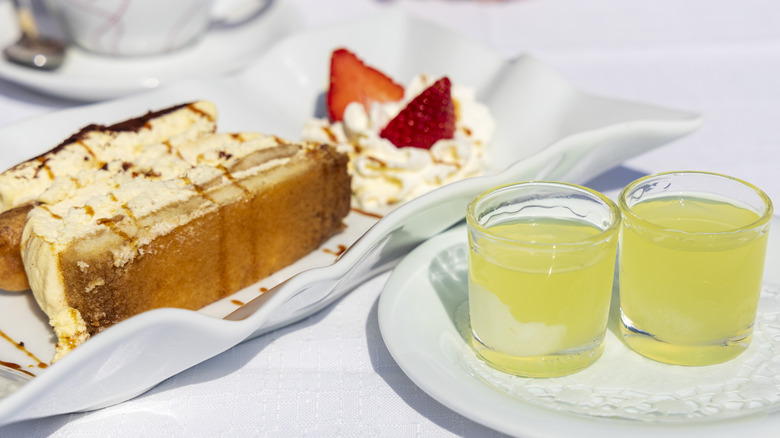The Iconic Sweet Drink You Might Get For Free At The End Of A Meal In Italy
If you've ever dined in Italy, you may have been surprised by a small, chilled glass of bright yellow liquid brought to your table at the end of your meal — even if you didn't order it. That's limoncello, an iconic Italian liqueur known for its refreshing sweetness and vibrant lemon flavor. Northern Italy offers a variant of it called limoncino. Often served as a complimentary digestive — that's right, on the house — limoncello is a quintessential part of Italy's culinary and hospitality culture. Plus, it's a delightful way to round off a meal.
Limoncello is a naturally flavored liqueur made from the zest of lemons, with sugar, water, and alcohol. Its bold, tangy sweetness and smooth texture sets it apart from other digestives and liqueurs. The lemons used are typically Sorrento lemons, which are grown in the sun-soaked region of southern Italy, particularly along the Amalfi Coast, the Island of Capri, and around Naples. Sorrento lemons are known for their large size, thick peels, and intensely fragrant zest — perfect for creating the rich flavor limoncello is famous for. When life gave Italians lemons, they made limoncello!
In Italy, it's customary to finish a meal with a digestive ("digestivo"), an alcoholic drink believed to aid digestion. Amaro, grappa, and sambuca are examples of digestivi. Limoncello is a very popular choice — it's the second most popular liqueur in Italy, in fact — especially in the south of the country, where it originated. After having multiple courses of pasta, meats, and cheeses, Italians like to enjoy a small glass of limoncello to refresh their palate and help with digestion. You begin your meal with an aperitivo, end it with a digestivo, and finish everything off with the after-dinner ritual of la passeggiata.
How to enjoy limoncello in Italy
What makes the experience even more special is that, particularly in family-run trattorias and other restaurants throughout Italy, limoncello is often offered for free as a way to say "grazie" ("thank you") for dining with them (especially if you've been a good guest). This gesture of hospitality is rooted in Italian culture, where meals are meant to be savored wholeheartedly, and guests are treated like family. So, if the waiter brings out the limoncello with the bill, without you asking for it, then it's free. It won't appear on your bill, and the restaurant is not trying to rip you off. However, if the waiter asks you if you want an after-dinner drink before he brings the bill, you'll most likely be charged for the limoncello.
Limoncello is best enjoyed straight from the freezer, served in small, chilled glasses. Due to its alcohol content, around 24% to 32%, it doesn't turn into a solid block of lemon ice when placed in the freezer. Instead, the beverage becomes thick and syrupy, with its citrus flavors and aroma enhanced. However, despite being served in a shot glass, don't shoot the drink — limoncello is meant to be sipped slowly. While it's traditionally an after-meal drink, it can also be sipped on its own on a warm afternoon, or used as an ingredient in cocktails (limoncello spritz, for example), desserts, or even drizzled over gelato. So the next time you find yourself in Italy, don't be surprised if a restaurant brings you a complimentary glass of this iconic lemon liqueur. Enjoy it! This is la dolce vita.

